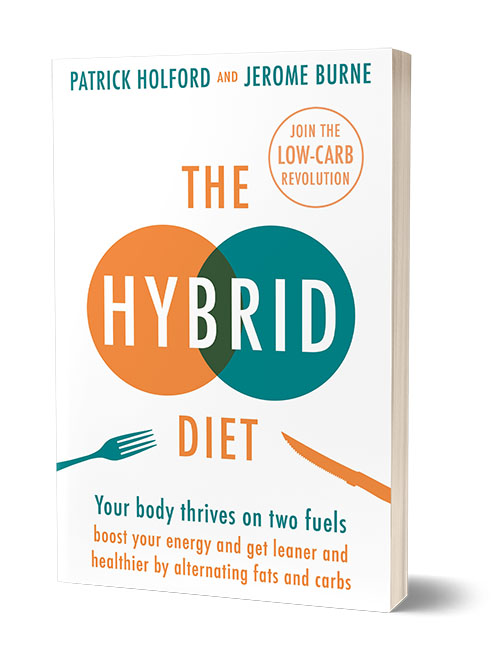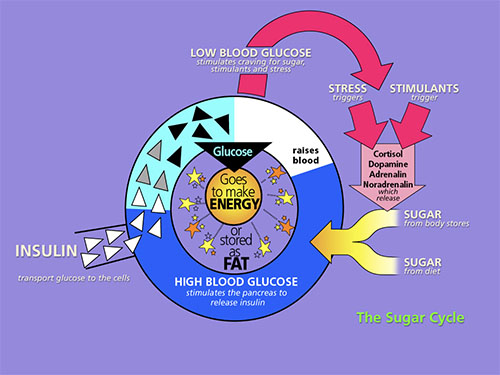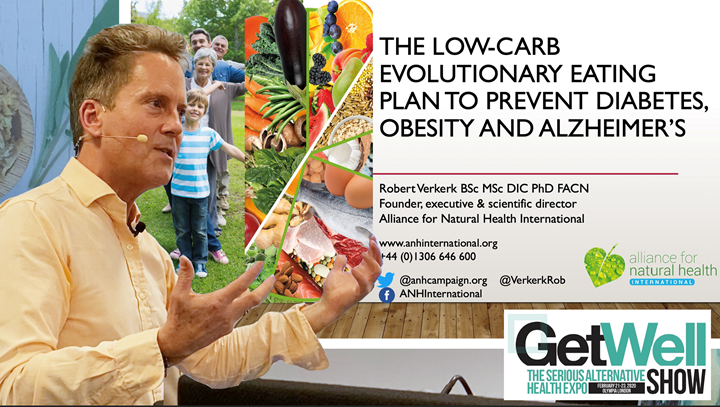Content Sections
By the ANH-Team
If you have even the slightest interest in diet, you’ll have noticed that the stand-off between mainstream ‘high carb/low fatters’ and the Paleo-influenced ‘low-carbers’ has recently reached fever pitch. With both camps in battle mode, there are few winners. The devoted ‘high carbers’ keep munching their wholegrains while being ever watchful over how much low-fat yoghurt – including plant-based varieties in the case of the growing band of vegans – they dollop on top. The devoted low carbers remain equally entrenched, more and more going ‘carnivore’ and leaving plant foods out of their diets altogether. Both camps scream loudly about their successes. The majority of the population carry on munching their burgers and processed foods, thinking there can’t be too much wrong with the middle ground. Perhaps they forget they’re as good as emanating government guidelines, but still getting ever fatter and sicker. Net result? Nothing changes. Citizen Joe says I might reconsider what I’m eating once the experts stop arguing.
Enter a new book to be released next week, authored by ANH friends Patrick Holford – nutritionist and prolific author – and Jerome Burne – award-winning medical and health journalist with a passion for getting under the cover of controversial medical issues. The book’s called “The Hybrid Diet” (Piatkus, 416 pages) and is available from 21 March. The subtitle titillates further: “Your body thrives on two fuels - discover how to boost your energy and get leaner and healthier by alternating fats and carbs”.
Going hybrid
It seems almost every day we hear people quoting the definition of insanity as “doing the same thing over and over again, and expecting different results” (a misattribution to Einstein). A good case in point is governments issuing the same basic healthy eating advice to their populations over more than 4 decades. It’s involved getting most of one’s energy (calories) from carbs and cutting back on fats, especially saturated fats. Protein, the other macronutrient, has been much less contentious, but that’s mainly because the science isn’t well enough understood by the authorities or the epidemiologists who’ve been cosying up with government authorities and Big Food for years.
Hybrid Diet could be regarded as something of a peace offering between the feuding parties. Its primary tenet is that our bodies are built to burn two fuels, carbs and fat, and most people will do better if they switch between the two fuels at different times.
Ironically everyone can burn carbs, despite them being non-essential to human life. More importantly, our modern lifestyles mean that, for many, our fat burning metabolism has shut down through disuse. That’s despite it being the evolutionary norm and our cleanest burning fuel.

Hybrid Diet will help people to learn how to switch between burning both fuels again. In essence, it brings more flexibility to your metabolism. Metabolic flexibility and resilience being something we’ve been advocating for years. In the process, you can get acquainted with all the things for which ketogenic diets are renowned, including fat burning, brain health, clean-up and repair duties courtesy of autophagy, building muscle strength through mitophagy, and more.
It also explains why some people can tolerate carbs better than others and why some benefit so greatly when they go classic ketogenic, consuming less than 5% of their dietary energy from carbs.
 Source: The Hybrid Diet: The sugar cycle — how insulin works
Source: The Hybrid Diet: The sugar cycle — how insulin works
It’s refreshing to see a book that isn’t just plugging one kind of diet. While the book shows you how you can shift your carb intake from one end of the spectrum to the other, while making sure they’re always slow-burning carbs, it offers a more import lesson. That’s about learning more how our metabolism and physiology actually works – in a very accessible way. Keeping it accessible is after all Patrick and Jerome’s signature.
We applaud their effort. Not only is this a book that everyone should read, if we’re going to have a medical profession that’s going to come to grips with the metabolic disease crisis we currently face, it should on the reading list of every medical student.
Read more on The Hybrid Diet at Jerome Burne's blog site, HealthInsight UK or www.hybriddiet.co.uk
Important Note from ANH:
After listening to that short animation you might be lulled into thinking that metabolic change can be achieved in a week. That might be true for those that are already metabolically flexible and resilient, but in our experience (8 years+) those that have been metabolically dysregulated (overfat, genetically disadvantaged, insulin resistant, type 2 diabetics, sedentary, chronically inflamed or suffering with a chronic disease for example) for a long time there is a need for an adaptation phase. The adaptation phase is different for different people because we're all so genetically unique, but be prepared for it to last anywhere between 6 - 10 weeks before your body is stable in its metabolic shift. By that time you'll be able to have longer interludes between meals with stable blood sugar and you might even have engaged in intermittent fasting periods because you're now able to burn fats for energy. That said, even though the first few days might be tough as your metabolism gets a kick in the pants, it really doesn't take long before you start reaping multiple benefits - often from week 2, which really helps with motivation and the will to continue.







Comments
your voice counts
13 March 2019 at 7:35 pm
Might be similar to Zoe Harcombe's successful diet plan, where you don't mix carbs with fats and leave several hours between each?
13 March 2019 at 8:48 pm
Many thanks for sharing and I will certainly be keen to read Patrick & Jerome's new book.
What came up for me after reading your blog was - Metabolic Typing (MT). To come clean, I've been a fan and advisor of MT since 2004, when I started my first CHEK, Holistic Lifestyle Coach (HLC) course with Emma Lane ND. MT was introduced to me and so was Wolcott and Fahey's book "The Metabolic Typing Diet" 2000. It's not actually a diet and to my understanding Bill had to use that term – ‘DIEt’, so that his publishers would publish their book!
The fact is, there is a no-one-size-fits-all DIEt. It does depend on how an individual absorbs, digests, assimilates and then eliminates their foods/products. That of course depends on the season, the location, the soil the foods they consume are produced (Is it devoid of the magnitude of life enhancing minerals, trace elements, bacteria, fungi, parasites, etc required to create health biodynamic soil), transportation, time until consumption, toxins in the soil and en-route to our kitchen table, how hydrated a person is, their enzymatic pathways, their present state of being (Or State Management as Tony Robbins might say), cephalic response (Are they at peace when eating their local, seasonal organic foods?), HCL production, present nutrient levels, body pH, ANS, sterol hormone system balance, etc, etc.
If I was an Eskimo, 90% of my daily diet would be fat and protein. Q: Do you see Inuit tribes lining up to see nephrologists with kidney issues due to their high fat and protein diet? No! yet, if you go to North Pakistan and visit the Hunza tribe, their DIEt is mainly 65% CHO! So, what would happen if you switched their DIEt’s? Yep, you got it, they each would become sick over time and suffer from malnutrition.
My point is, our physical body will never, ever lie to us. If it did, we’d die! That said, if you study Dr Roger Williams’ work, “Biochemical Individuality” you’d soon learn that the size of our organs are unique to us, therefore so is our nutritional DIEt.
In the words of one of my great teachers, Paul Chek, “If you love it, rotate it”. Don’t consume the same foods each day. Allow at least 72hrs between the same foods, so your body doesn’t create the opportunity of intolerances to start.
So, what are the right foods for me? Simple, a food that doesn’t cause inflammation or irritation internally. Most dis-eases start in our guts/stomach, so many people due to ‘lamestream media’ consuming a BAD/SAD CRAP DIEt that the ‘Jones’’ follow, such as consuming cereals (Cereal killers if they feed their children - ‘Killogg’s’, GM, etc), bread, pasta (And I’m not saying Gluten free is any better!), sugar laden, Low fat, processed veg oils, zero calories, packaged, processed, etc, are digging their grave one fork at a time unconsciously… until their proverbial foot falls off! Why wait to become disabled, do something about it now!
There’s a simple form of kinesiology (Study of how your body moves), which looks at one’s pulse rate. Once a person knows their normal resting pulse, place a food item or supplement on the roof of their mouth. After one min. retest your pulse. Up or down by 5+ beats then you may well be intolerant to whatever you’re consuming! Bottom line – LISTEN TO YOUR BODY.
We are all uniquely, divinely different on so many fronts.
BAD – British Average DIEt
SAD – Standard American DIEt
CRAP – Caffeinated, Refined, Alcohol/Additives and Processed
13 March 2019 at 9:48 pm
Patrick here. Many thanks for this. We're also running 3 hour seminars on the Hybrid Diet throughout the UK and Ireland, starting on March 20th till mid April. Details of the seminars can be found at www.hybriddiet.co.uk
19 March 2019 at 11:21 am
I'm disappointed to see soya in this book in the form of milk and yoghurts (ie not the fermented kind). I am of the opinion that these are highly processed foods and not at all good for you?! There are so many dairy alternatives out there now I don't think those that are dairy intolerant/allergic/vegan should use such products as I'm not sure they are at all healthful.....
Apart from this, it is a really good read - I am a big advocate of low GL in my clinic and I will now have the high fat phase to consider too.....
Your voice counts
We welcome your comments and are very interested in your point of view, but we ask that you keep them relevant to the article, that they be civil and without commercial links. All comments are moderated prior to being published. We reserve the right to edit or not publish comments that we consider abusive or offensive.
There is extra content here from a third party provider. You will be unable to see this content unless you agree to allow Content Cookies. Cookie Preferences